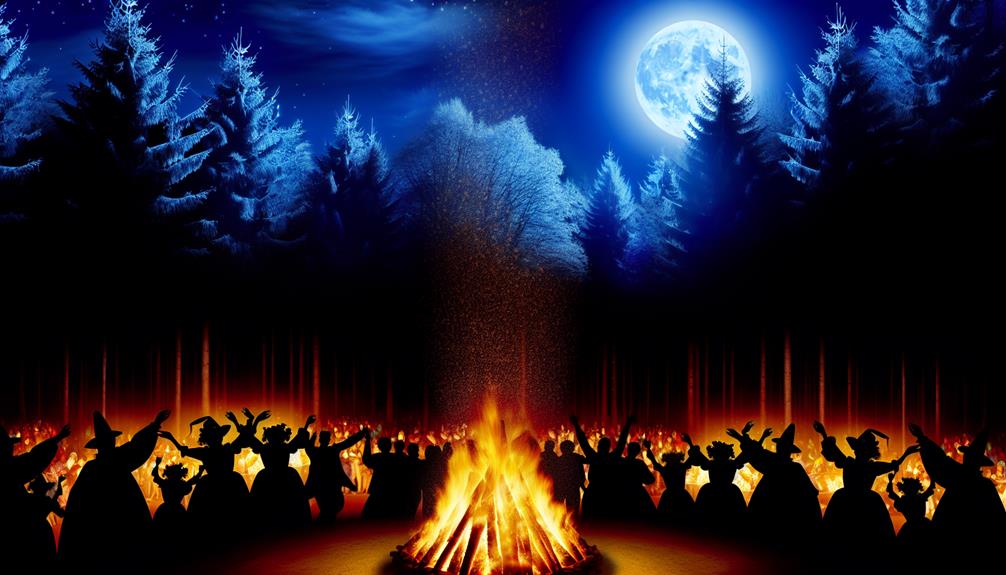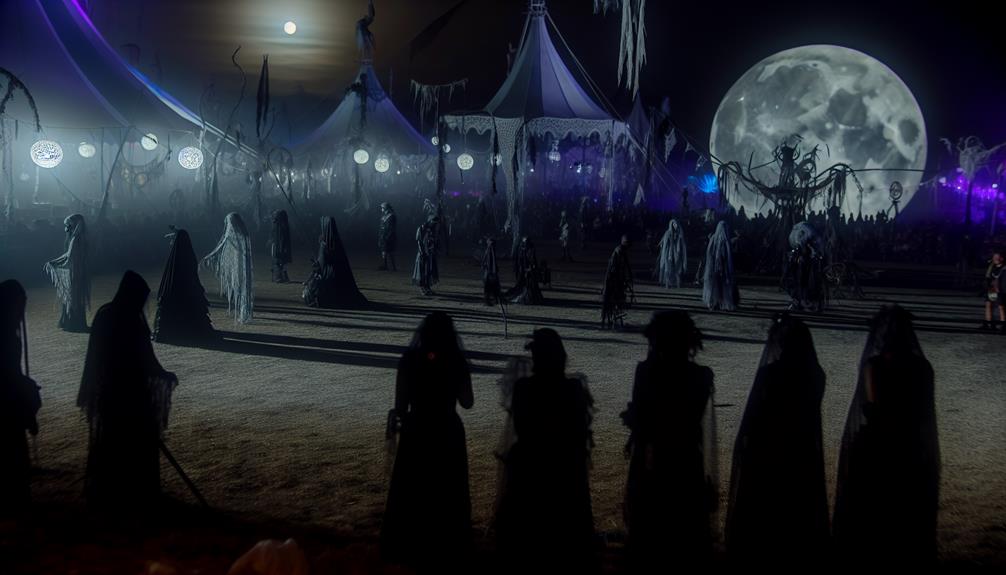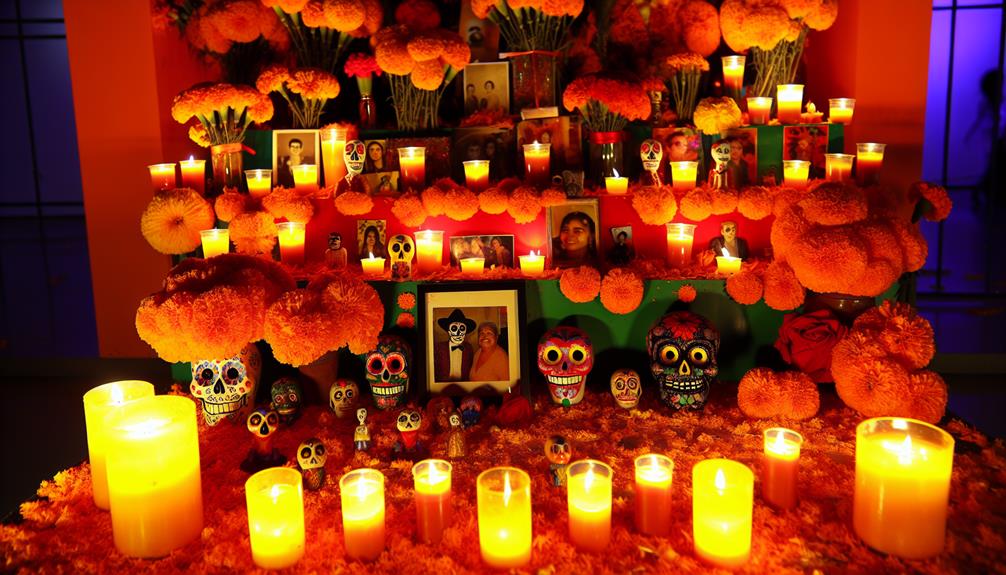The mystical allure of Walpurgis Night in Germany beckons with a tapestry of ancient customs interwoven with contemporary revelry. As bonfires flicker against the night sky and masked figures whirl in dance, this celebration transcends time, bridging the gap between folklore and modernity. From the origins shrouded in mystery to the regional nuances that flavor each festivity, Walpurgis Night emerges as a cultural mosaic waiting to be explored. Join us on a journey through the traditions and folklore surrounding this enchanting event, where past and present converge in a harmonious celebration of heritage and community.
Key Takeaways
- Walpurgis Night in Germany merges pagan fertility rites with Christian traditions.
- Bonfires are lit to ward off evil spirits and celebrate the arrival of spring.
- Festivities include traditional costumes, masks, music, and dance celebrations.
- Modern observance blends old and new traditions, reflecting cultural dynamism.
- Walpurgis Night boosts tourism, revenue, and showcases local products, benefiting the economy.
Origins of Walpurgis Night
What are the historical origins of Walpurgis Night in Germany and how have they influenced its modern observance?
Walpurgis Night, also known as Walpurgisnacht in Germany, has deep cultural traditions and historical roots that continue to shape its modern observance. This night is celebrated on the eve of May Day, honoring Saint Walpurga, an 8th-century abbess who was canonized on May 1st. However, the origins of this celebration predate the Christian influence, as it was believed to have pagan roots tied to fertility rites and the arrival of spring.
Historically, Walpurgis Night was a time to ward off evil spirits and celebrate the end of the harsh winter months. People would light bonfires, dance, and make loud noises to scare away any lingering winter spirits. Over time, the Christianization of this holiday merged these pagan traditions with the commemoration of Saint Walpurga, creating a unique blend of customs that are still observed today.
These historical roots have heavily influenced the modern observance of Walpurgis Night in Germany. Today, it is a time for communities to come together, light bonfires, and celebrate the arrival of spring. It is a night filled with music, dancing, and merriment, reflecting a mix of pagan and Christian traditions that have been passed down through generations. The cultural significance of Walpurgis Night remains strong, connecting people to their past and providing a sense of unity and freedom in celebration.
Significance of Bonfires
The tradition of lighting bonfires during Walpurgis Night in Germany holds significant cultural and symbolic importance, embodying centuries-old customs intertwined with both pagan and Christian influences. The lighting of bonfires on the night of April 30th is deeply rooted in cultural traditions and historical symbolism, reflecting a blend of ancient rituals and religious practices.
| Cultural Traditions | Historical Symbolism |
|---|---|
| Bonfires are lit in various parts of Germany, bringing communities together for festivities and celebrations. | Historically, bonfires were believed to ward off evil spirits, marking the end of winter and welcoming the warmth of spring. |
| People gather around the bonfires, singing, dancing, and enjoying traditional foods and drinks. | The tradition of bonfires during Walpurgis Night dates back to pre-Christian times when fires were lit to celebrate the changing of seasons and fertility rites. |
| The act of jumping over the bonfire is believed to bring good luck and protection for the coming year. | In Christian tradition, the bonfires are associated with Saint Walpurga, known for her healing powers, and the fires symbolize the light of her teachings spreading across the land. |
These bonfires not only serve as a means of celebration but also as a reminder of the rich cultural heritage and the enduring traditions that have been passed down through generations.
Traditional Costumes and Masks
With bonfires illuminating the night sky during Walpurgis Night in Germany, the traditional costumes and masks worn by celebrants add an intriguing layer of cultural significance to the festivities. Costume traditions play an essential role in the Walpurgisnacht celebrations, with many participants donning elaborate outfits that harken back to ancient folklore and traditions. Women often wear long flowing dresses in vibrant colors, adorned with floral patterns or ribbons, symbolizing the arrival of spring and fertility. Men opt for traditional attire such as lederhosen or dark trousers paired with embroidered shirts, reflecting a connection to the region's rural heritage.
In addition to costumes, mask designs are a central aspect of the Walpurgisnacht festivities. Masks are crafted with meticulous detail, often featuring intricate carvings and bright colors that represent various mythological creatures and spirits. The masks serve not only as decorative pieces but also as a way to conceal one's identity, allowing participants to embody different characters and personas during the celebrations. Common motifs found in these masks include animals like goats, wolves, and bears, as well as mystical beings like witches and demons, adding an element of mystery and enchantment to the night's events.
Dance and Music Celebrations
During Walpurgis Night in Germany, the dance and music celebrations serve as a testament to the vibrant cultural festivities, showcasing a rich tapestry of traditional rhythms and movements. Dance performances during Walpurgis Night are a fusion of ancient folklore and modern interpretations, where locals and visitors alike can witness a variety of traditional German dances. These dances often reflect themes of spring, fertility, and the triumph of light over darkness. The rhythmic footwork, colorful costumes, and lively music create an enchanting atmosphere that captivates audiences.
Musical concerts are another highlight of Walpurgis Night, with performances ranging from classical compositions to contemporary pieces. Musicians from different genres come together to serenade the crowds with melodies that evoke the spirit of the season. Traditional instruments such as the accordion, clarinet, and drums are commonly featured, adding a unique charm to the musical landscape of the celebrations.
The dance and music celebrations offer a platform for local artists to showcase their talents and for the community to come together in a shared expression of joy and unity. Whether it's the graceful movements of a traditional dance troupe or the soul-stirring notes of a live orchestra, the performances during Walpurgis Night demonstrate the cultural richness and artistic diversity of Germany.
Regional Variations in Germany
Regional variations in Germany manifest in diverse customs, traditions, and cultural practices that reflect the unique heritage of different areas across the country. These variations contribute to the rich tapestry of German culture and create a sense of local identity and pride.
Here are three key aspects of regional differences in Germany:
- Cultural Traditions: Germany is known for its rich cultural tapestry, with each region boasting its own set of traditions and customs. For example, in Bavaria, traditional costumes like Lederhosen and Dirndls are commonly worn during festivals, while in the Rhineland, colorful Karneval celebrations dominate the streets. These cultural traditions are passed down through generations, shaping the identity of each region.
- Local Customs: Local customs play a significant role in defining the uniqueness of each German region. From the culinary delights of Swabian cuisine in Baden-Württemberg to the maritime traditions of the North Sea in Lower Saxony, local customs offer a glimpse into the daily lives of the people living in different parts of Germany. These customs often revolve around food, festivals, and social gatherings that bring communities together.
- Festive Celebrations: Festivals and celebrations vary across Germany, with each region showcasing its own festive spirit. For instance, the Oktoberfest in Munich is world-renowned for its beer tents and lively atmosphere, while the Christmas markets in cities like Nuremberg and Dresden offer a magical winter wonderland experience. These festive celebrations are deeply rooted in local customs and traditions, attracting visitors from far and wide to experience the unique charm of each region.
Modern Observance and Festivities
In contemporary Germany, the observance and festivities surrounding regional traditions have evolved to incorporate modern elements, reflecting a dynamic blend of heritage and innovation. Modern traditions are increasingly shaping the way Walpurgisnacht is celebrated in various regions across the country. Cultural influences from diverse sources, including popular culture and global trends, have started to intertwine with traditional practices, creating a unique tapestry of customs.
One notable aspect of modern observance is the incorporation of technology into the festivities. Many celebrations now feature light shows, laser displays, and multimedia presentations that add a contemporary flair to the traditional bonfires and processions. This fusion of old and new elements attracts a broader audience, including younger generations who are drawn to the cutting-edge aspects of the event.
Furthermore, the culinary landscape of Walpurgisnacht has also undergone a transformation, with traditional dishes being reinvented to cater to modern tastes. Street food stalls offering a fusion of traditional German cuisine with international flavors have become increasingly popular during the festivities. This culinary evolution reflects the ongoing dialogue between past and present, as well as the influences of globalization on local traditions.
Folklore and Superstitions
The folklore and superstitions surrounding Walpurgis Night in Germany are deeply rooted in centuries-old beliefs and cultural practices. This night, on the eve of May Day, is steeped in mystery and tradition, making it a fascinating subject for those interested in the supernatural.
Here are some intriguing aspects related to the mythical creatures, legends, rituals, and customs associated with Walpurgisnacht:
- Mythical Creatures and Legends: One prevalent belief is that on Walpurgis Night, witches gather on the Brocken, the highest peak of the Harz Mountains. According to folklore, this is where they hold a grand meeting, reveling in celebrations and performing magical rituals. The Brocken is shrouded in eerie tales of sorcery and otherworldly encounters, adding to the mystique of the night.
- Rituals and Customs: To ward off evil spirits and protect themselves from malevolent forces, people in Germany light bonfires on Walpurgis Night. The flames are believed to cleanse the surroundings and bring good luck for the coming year. Additionally, some communities organize parades, costume parties, and traditional dances during the festivities, paying homage to age-old customs.
- Legends of Saint Walpurga: The night is named after Saint Walpurga, an English missionary who helped spread Christianity in Germany. Over time, her name became intertwined with the pagan celebrations of spring, blending Christian and pre-Christian beliefs into a unique tapestry of folklore surrounding Walpurgis Night.
Impact on Tourism and Economy
With the growing popularity and cultural significance of Walpurgis Night in Germany, the event's impact on tourism and the local economy has become increasingly significant. Tourism revenue during the Walpurgisnacht period experiences a notable surge as visitors from all over the world flock to witness the unique celebrations and festivities. The influx of tourists brings about a boost in revenue for various sectors including accommodation, food and beverage, transportation, and local attractions.
Local businesses also benefit greatly from the heightened economic activity surrounding Walpurgis Night. Hotels, restaurants, souvenir shops, and tour operators experience a spike in sales during this period, leading to increased profits and opportunities for growth. The demand for goods and services rises, creating a positive ripple effect on the overall economy of the region where the celebrations take place.
Moreover, the event serves as a platform for local artisans and vendors to showcase their products to a broader audience, further stimulating the local economy. Small businesses, in particular, seize the opportunity to capitalize on the influx of visitors by offering unique products and services tailored to the spirit of Walpurgis Night. Overall, the impact of Walpurgis Night on tourism and the local economy is undeniable, making it a crucial driver of economic growth and prosperity in the regions where it is celebrated.
Frequently Asked Questions
Are There Any Specific Foods or Drinks Associated With Walpurgisnacht Celebrations?
Traditional delicacies and festive beverages are often central to cultural celebrations worldwide. These offerings vary greatly depending on the region and customs. From savory dishes to sweet treats, each event may feature unique culinary specialties that hold symbolic significance.
Similarly, festive beverages play a role in enhancing the overall experience, often reflecting the flavors and traditions of the occasion. These elements add a sensory dimension to the festivities, enriching the celebratory atmosphere.
What Are Some Popular Souvenirs or Crafts Related to This Festival?
Craft markets around the world offer an array of souvenirs and traditional gifts that capture the essence of various festivals. When exploring these markets, one might find exquisite handmade items like wooden masks, intricately designed candles, and embroidered textiles. These crafts not only serve as mementos but also provide insight into the cultural significance of the festival they represent.
Craft markets become a treasure trove of unique and meaningful keepsakes for visitors to cherish.
Is There a Specific Ritual or Tradition for Predicting the Future During Walpurgis Night?
When exploring the practice of predicting the future without the context of a specific event, various traditions and rituals are often employed, such as tarot readings and fortune telling. These methods can involve interpreting symbols, cards, or other divination tools to provide insights into what the future may hold.
Additionally, midnight bonfires and masquerade costumes are sometimes incorporated into these rituals to create a mystical ambiance conducive to seeking glimpses of what is to come.
How Do Local Businesses Prepare for the Influx of Tourists During This Event?
Local businesses meticulously plan for the surge of tourists during large events, focusing on event decorations to captivate visitors. They engage in extensive community involvement initiatives to create a welcoming atmosphere and enhance the overall experience.
Are There Any Special Accommodations or Packages Available for Visitors Attending Walpurgisnacht?
When it comes to accommodating visitors attending events, various options exist to cater to different needs. Accommodation options range from budget-friendly hotels to luxurious resorts, offering a diverse selection to suit various preferences.
Travel packages may include accommodation, transportation, and event tickets bundled together for convenience and cost-effectiveness. These offerings aim to enhance the overall visitor experience by providing a seamless and enjoyable stay during the event.
Conclusion
To sum up, Walpurgis Night in Germany represents a harmonious fusion of ancient traditions and modern celebrations.
The bonfires symbolize the triumph of light over darkness, while the traditional costumes and masks showcase the cultural richness of the event.
The dance and music performances add vibrancy to the festivities, attracting tourists and boosting the local economy.
Overall, Walpurgis Night is a mesmerizing display of cultural heritage and community spirit.


